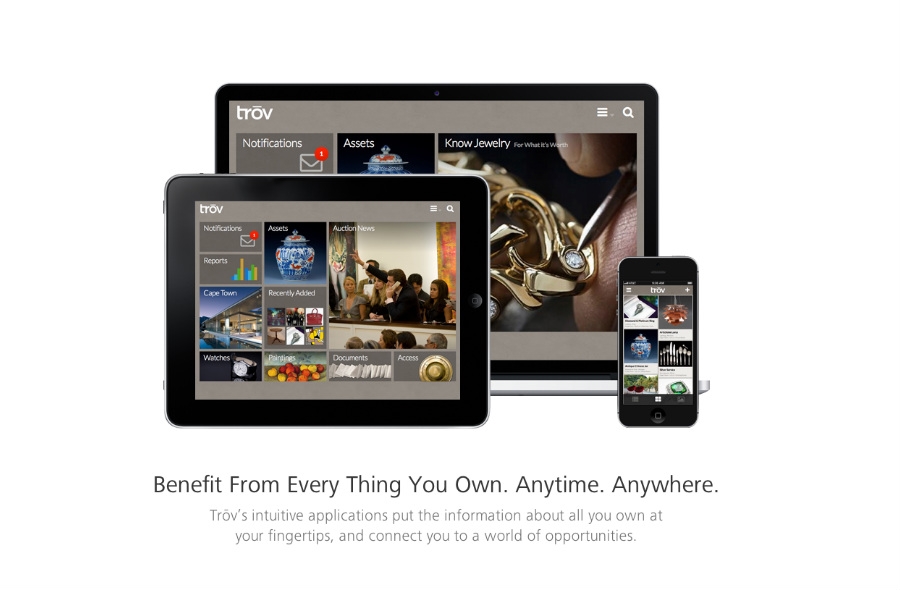
There is “significant value” locked up in the information about things that people own and are acquiring, says Scott Walchek, chief executive at Trōv.
Trōv describes itself as a private cloud-hosted “digital locker” where information about personal property and possessions is collected, organized and continuously updated. Trōv members can then use this information to sell, borrow against or take other actions to leverage the value of what they own.
Individuals are increasingly turning their attention to what financial rewards their treasures may afford. For example, a 2011 ACE Private Risk Services study of HNW households found that 74 per cent of respondents cited investment value as a reason to buy rare art, wine, jewelry, sports memorabilia or classic cars. Meanwhile, a more recent Barclays report found that high net worth individuals in the US hold an average of 9 per cent of their wealth in tangible assets.
“Investors are increasingly looking to hard assets, such as valuable art, antiques or fine watches and wine collections, because of the perceived ability of these assets to hold value during market fluctuations,” said Tom Livergood, CEO and founder of The Family Wealth Alliance, in a new report published by Trōv and ACE Private Risk Services.
“Blind spot”
While the above-mentioned report argues that tangible assets are a “dramatically underappreciated” component of wealth planning, it also acknowledges that their market value can change rapidly.
“There is a huge risk and reward in today’s market because so many investors are entering uncharted territory,” said Alan Fausel, vice president and director of the fine art department in the New York office of London-based auction house Bonhams.
But Walchek believes that mobile and cloud technologies are changing for the better the way tangible assets are collected, valued and managed. He argues that most people don’t have a clear idea of what they own, where it’s located or what it’s worth. If they do track their valuables, the information is generally stored “piecemeal on spreadsheets, hard drives, or in file cabinets.” he said.
The number representing a client’s tangible assets is being relegated to “one or two lines” on the balance sheet, when there is “a lot more information to be unlocked,” he continued.
“The world is more connected now and data is abundant about every asset class, from property to art, wine, jewelry etc….with our relationships and technology we can grab all that information and start to explode those two lines on the balance sheet to something that is so much more meaningful.”
How Trōv it works
There are a number of ways that a member can add to their Trōv, including the use of automated import, e-receipts, merchant point-of-sale, the Trov Mobile app and on-site collection.
“The closer to automated we can get, the better it will be for our end-users,” Walchek noted.
Trōv’s back-end captures the item information, labels the purchase, correlates it with related information from the Internet, and then securely stores the data. As items are added and/or values change, members can choose to automatically notify their insurance broker or wealth manager. They can also connect to Trōv partners to borrow against, sell, insure, or donate their possessions as values fluctuate.
But client concerns and awareness about security and privacy has never been greater, with the issue of how to handle data protection arguably one of the most important facing the wealth management industry today. On this note, Walchek outlined the various security steps Trōv takes in safeguarding the privacy of information stored. (At present, Walchek said his firm has around 240,000 individual items in the “global Trōv,” which has a value of roughly $2.4 billion.)
First and foremost, he said, Trōv doesn’t actually own the information obtained, and, secondly, “we never sell your data.” Additionally, the firm has hired staff to build a system that enables the full encryption of data, and, crucially, this key is not controlled by Trōv.
“We also have a director of privacy and security who oversees everything from processes to legal policies and technology,” Walchek said.
Lastly, he added that the firm is in the process of applying for a certificate which confirms that it is complying with the highest standards of privacy and personal information.
Target sector
Trōv’s efforts over the last 16-17 months have been geared towards the wealth management and property and casualty insurance high net worth channels. On the wealth management side, Trōv helps RIAs and other advisors add tangible wealth management to their services.
“Our target audience initially has been the 29.7 million HNW individuals around the globe. We believe they are most influenced by those on whom they rely on for either asset protection or financial advice. Our strategy has been to work from a position of brand strength in partnering with the likes of the major insurers and brokers in the US and UK,” Walchek said.
He added: “We know that the concept of Trōv will attract everyone from the mass affluent upwards. For the initial years we will be heavily focused on the HNW ($1 million or more in investable capital) and then we will begin to expand into the mass affluent in 2014 and beyond.”
When asked about revenue generation, Walchek said: “Where we make our money is when people transact – i.e. borrow, sell, insure their items and donate. Trōv takes a small slice of each transaction.”
Eliane Chavagnon
Deputy Editor – Family Wealth Report

